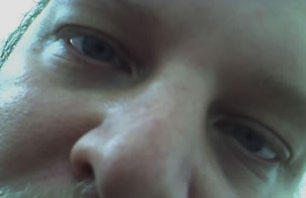I'm not. None of us are. None of us, fully, are "progressive", "liberal", "left wing" (or "Democrat"); none of us, fully, are "reactionary", "conservative", or "right wing" (or "Republican").
I wrapped myself up in the "Liberal Leaning Libertarian" (LLL... catchy!) label to muddy the waters... and clear them. I recognized the need to add at least another dimension to the political label I used to situate myself. Thus, I claim to be a "social liberal" and a "small government fiscal conservative"... LLL.
It seems that I'm in good company with this right/left dichotomy discontent. A gentleman named Noah Millman has come up with a new taxonomy for the political spectrum based on three dimensions, which I think is absolutely perfect. His three axes of political thought are:
1. Liberal versus Conservative.
"A liberal is someone who is generally impressed with the capacity of an individual, and who therefore wants individuals to be free to develop those capacities. Liberal distrust of authority and belief in the importance of open minds and freedom of inquiry stem from this basic assumption.2. Left versus Right.
"A conservative by temperament takes the opposite side in this dispute. [P]eople are not so much moved by ideas as by sentiments. Not only are human beings fundamentally selfish, they are frequently perverse. Deference to authority combined with an intense concern for the nature of that authority and its legitimate grounds grows naturally in conservative soil.
"Put simply: a liberal outlook trusts individuals and questions authority; a conservative outlook distrusts individuals and defers to authority."
"A left-wing perspective is animated by failure and the consequences thereof. Whether we’re talking about Rawlsian liberals or Christian socialists or orthodox Marxist-Leninists, the ultimate object of concern is the miserable of the earth. Their perspective, their needs, are the beginning and the end of political morality.3. Progressive versus Reactionary.
"A right-wing perspective is opposite to this. How to design a system that adequately rewards success is the essence of the right-wing political project. What constitutes "success" may vary among different kinds of right-wingers ... but these are all kindred spirits in that all are asking how to reward success, so that we get more of it, rather than how to mitigate the consequences of failure.
"Put simply: a right-wing perspective is animated by an affinity for the winners and their interests, while a left-wing perspective is animated by an affinity for the losers and their interests."
"The progressive is future-oriented. Things will — or could — be better in the future than they are now. But more than this, history has a direction that can be discerned, and that one must be cognizant of in constructing one's politics.
"The reactionary, by contrast, is past-oriented. Things will — likely — be worse in the future than they are now, just as they were better in the past. Apparent progress masks the loss of things that were more valuable than the novelties acquired."
 So, where do I align myself on this 3-dimensional continuum of political thought?
So, where do I align myself on this 3-dimensional continuum of political thought?1. Liberal versus Conservative. By this model, I'm fully Liberal: Nothing is more important to me than individual responsibility and freedom from government involvement in the regulation (other than in the strictest legal/illegal sense) of morals, behavior, and life choices. Yes to gay marriage, legalized drugs, euthanasia, pro-choice... all to be left to the individual. 100% liberal.
2. Left versus Right. I'm 50-50 here. Right in the middle. Basically, my belief is that the American federal government's sole responsibilities are to (1) ensure the health of the people (insofar as they are individually willing to be helped), (2) maintain the safety of the nation (insofar as it is collectively willing to be defended), and (3) enforce federal regulations of private enterprise that ensure (1) and (2). The rest of the responsibility goes to the states, or to individuals as they see fit.
I believe that "winners" and "losers" are not fully of their own making. I believe that people can do everything right and still wind up on the losing side of life, with the need for government to help them out. That's why I support full access to healthcare for everyone (with government help, if needed), but at the same time think that Social Security and other such programs should be voluntary because receiving government support should not be mandatory.
Similarly, I also oppose any and all efforts of government to restrict the path to success that people take (other than, again, in the strictest legal/illegal sense). I believe in flat taxes, minimization or elimination of estate taxes, and a laissez faire business environment, et cetera. However, I also fully support government regulation of business practices on a systemic level... such as the FDA, the FEC, the EPA, and so on, because it has been often proved that business (mistakenly or purposefully) acts against the interest of the greater public weal.
3. Progressive versus Reactionary. I'm fully progressive. Other than the preservation and appreciation of cultural and historical treasures, and the lessons learned from them, I do not value the past. I have very little faith in the applicability of history, tradition, or the status quo to the new and changing circumstances of humanity. I fully believe that there is always a better way of doing things, and that human advancement is founded on the trial (and error) of societal, political, and intellectual experimentation.
So: Under this new rubric, I'm a Progressive Liberal Centrist. Well, we shall see if the new nomenclature sticks. Otherwise, I'll stick with the tried-and-trusted "Liberal Leaning Libertarian".


1 comment:
View a continuum as a circle rather than a straight line and see what you come up with.
Hint, the poles can only distance themselves from each other from the starting point until they start coming together again.
Mike Farrell
Cagayan de Oro
Post a Comment